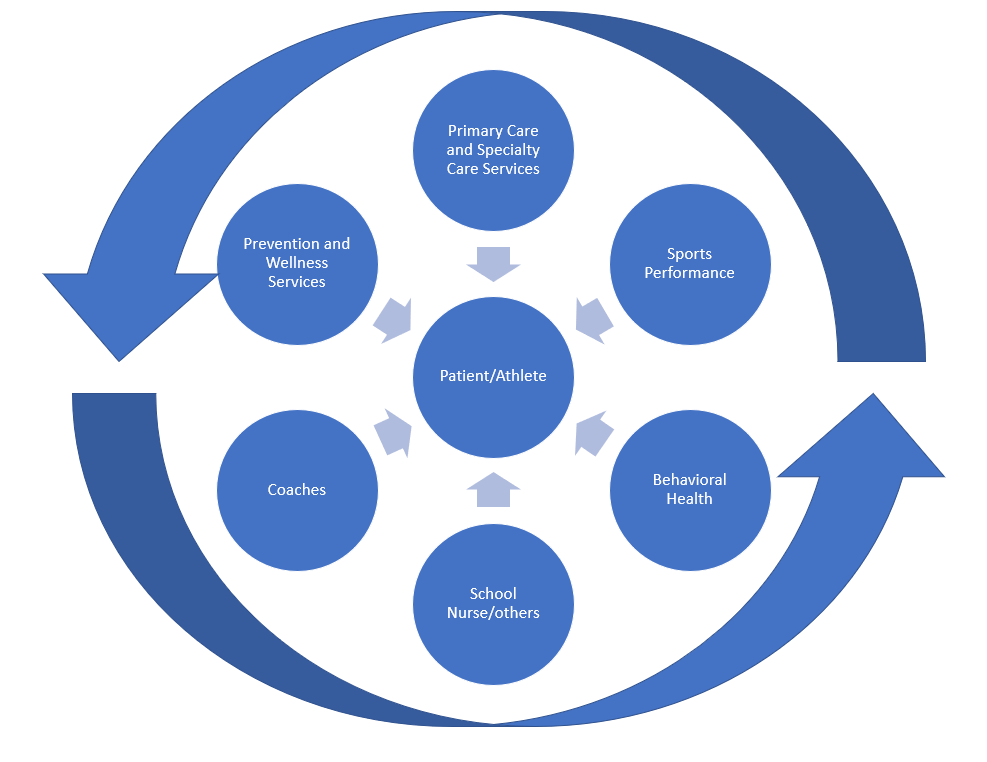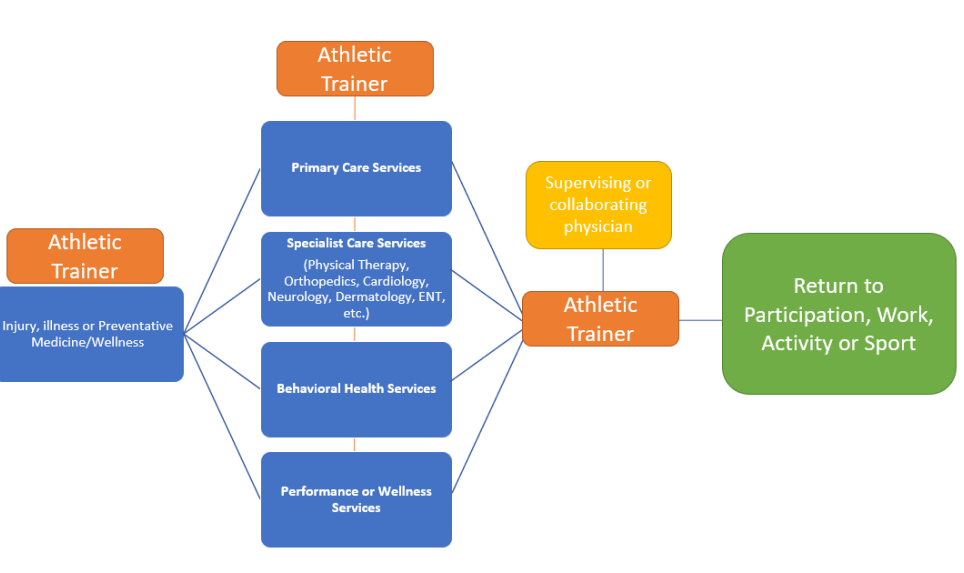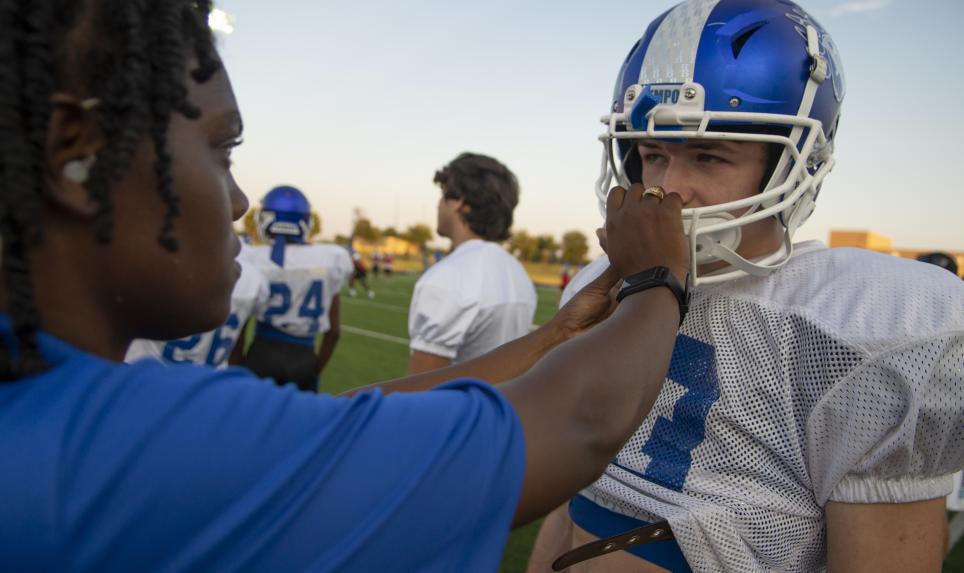The Quarterback of Health Care Team
Every great team, from businesses to sport organizations, has a team leader - an individual who can set key goals and major objectives, who works well under pressure, and who can skillfully and precisely slow the pace with ease. The leader understands the strengths and weaknesses of the team and can mitigate weaknesses by building an interdisciplinary collaborative environment that allows each member to practice to their maximum potential.
In football, this individual is often viewed as the captain or the quarterback. In the athletic health care team, there is only one profession with the skillset, education and personality to serve in this prestigious role. For years, athletic directors have been referred to as the “quarterbacks” of health care. And as health care teams continue to expand, the title becomes more etched in stone.
An athletic trainer is a licensed or regulated health care professional who, under the direction of or in collaboration with a physician, provides primary care, injury and illness prevention, wellness promotion, emergent care, examination and clinical diagnosis. They also provide therapeutic intervention, and rehabilitation of injuries and medical conditions, as well as return-to-activity recommendations (https://www.nata.org/about/athletic-training/athletic-training-glossary).
Athletic trainers can be found in a variety of settings such as schools, colleges, professional and Olympic sports, physician practices, hospitals, clinics, occupational health departments, municipal departments (police and fire,) branches of the military and performing arts. Their education uses a medical-based model to prepare athletic training students to provide comprehensive patient-centered care (Figure 1) (https://www.nata.org/about/athletic-training/education-overview).

Figure 1: Patient-Centered Care Model
Regardless of setting, athletic trainers are usually the first health care professional to interact with a patient and are often the individual they interact with most often. No matter the situation, whether it is an emergency or illness, athletic trainers have built an interdisciplinary team of medical experts, in a patient-centered model, willing to collaborate and provide the most effective and efficient care for the patient. When the situation is such that the athletic trainer can perform the services necessary and within their scope of practice, then they may do so. Or if the situation is such that it warrants a referral to other skilled professionals, athletic trainers will help guide flow of care for the patient, ensuring all members on the team are working on the same patient-centered goals. And if the situation is one in which the condition or situation is emergent, athletic trainers will execute the Emergency Action Plan, a plan that is rehearsed and refined year after year. The model below (Figure 2) provides a simplified flow process showcasing the unique role of an athletic trainer. Consider these three case scenarios.

A 17-year-old female soccer athlete collides with another teammate and immediately falls to the turf holding her knee. The athletic trainer present immediately runs to the athlete and provides an initial evaluation to determine the extent of the injury. Is this an emergency or is the patient stable to transport to the sideline for a more thorough evaluation? The athletic trainer determined on the field that most likely this athlete sustained a tear of the Anterior Cruciate Ligament (ACL) and therefore can safely be carried off the field. At this point, the athletic trainer now coordinates and facilitates the long path to recovery. From initial treatment, to scheduling an appointment with the primary care physician and other specialty care services, to ensuring the patient is referred for the proper diagnostic imaging, to surgery, rehabilitation, performance and ultimately return to sport, the athletic trainer, just like a skilled quarterback, is efficiently guiding the team, in a collaborative, professional manner to provide the most efficient and comprehensive care possible for the athlete.
A 25-year-old Police Cadet collapses in the parking lot on the way into the main police academy headquarters. The athletic trainer in the main clinic is called to the scene and determines the cadet is in Sudden Cardiac Arrest. Through years of preparation and highly-skilled training, the athletic trainer immediately activates the Emergency Action Plan. This plan has been carefully and meticulously rehearsed, lead by the athletic trainer, to the point that each member on campus immediately reacts. As the athletic trainer and another health professional are providing high-quality CPR, another runs and obtains the Automated External Defibulator (AED). Within two-minutes of the cadet collapsing, they are now breathing and conscious. From here, the cadet will be sent through the flow of services and diagnostic services and hopefully will be able to return to the academy and graduate.
A 47-year-old line working at an airline factory reports to the athletic trainer in the clinic onsite that they have a history of type-1 diabetes and is reporting difficulty completing their shift due to extreme thirst, headaches and weakness. The worker stated that they felt like they consumed an appropriate amount of carbohydrate drinks prior to work. The athletic trainer after conducting a thorough evaluation, including checking the workers blood glucose, determined that the worker is exhibiting symptoms of hyperglycemia and due to this, the patient should probably be administered insulin as prescribed by their physician. As the patient recovers, the athletic trainer educates the patient on the need to better manage their diabetes. The worker expresses that they are having difficulties both financially and emotionally at home. Upon hearing this news, the athletic trainer refers the worker for behavioral health services and nutritional services to better manage their diabetes.
The education and skillset of an athletic trainer is unlike any other professional. Coaches, school nurses, physical therapists, sports scientists, performance coaches/personal trainers and many others are highly skilled but if we consider emergent care, unbiased patient advocacy in return to play decisions and orchestration of positive interdisciplinary collaboration both on campus and within facilities, athletic trainers are the only professionals qualified to fill the role as Quarterback.

Adam Annaccone, EdD, LAT, ATC, CES, PES, Assistant Clinical Professor- Athletic Training, Director, Standardized Patient Lab, Department of Kinesiology, College of Nursing and Health Innovation, The University of Texas at Arlington
